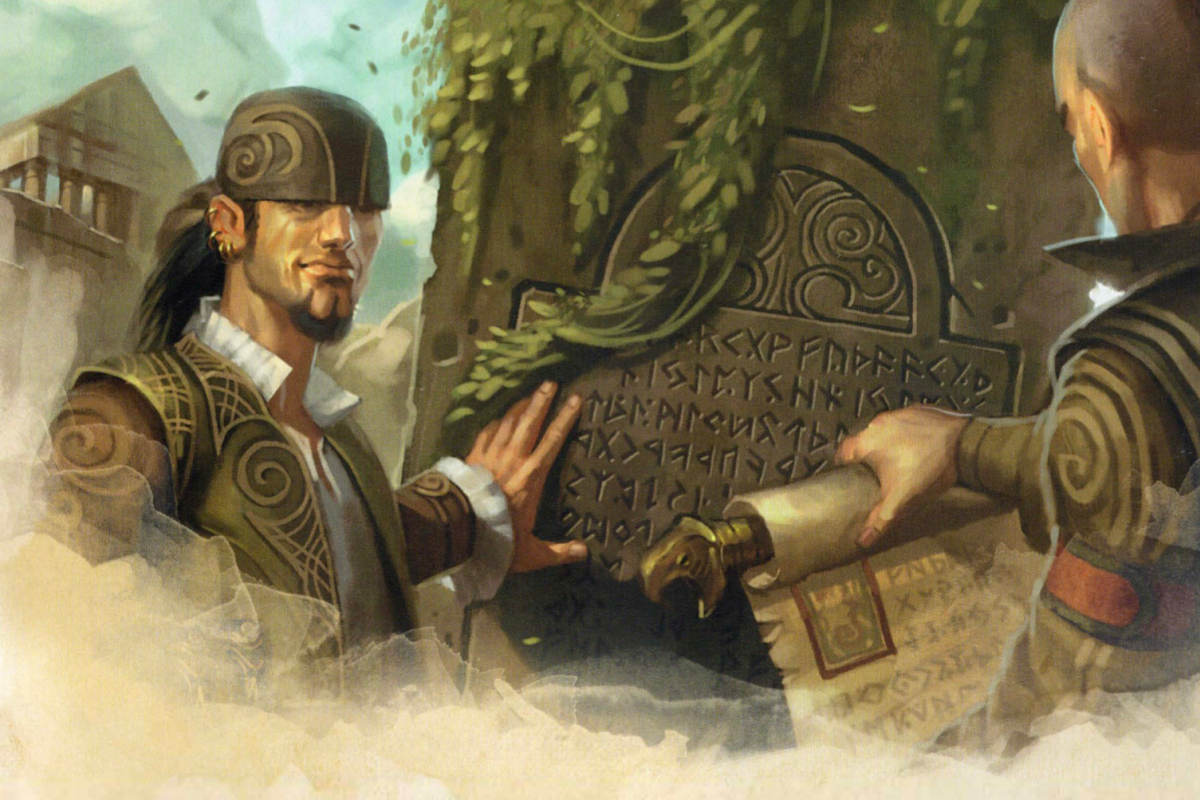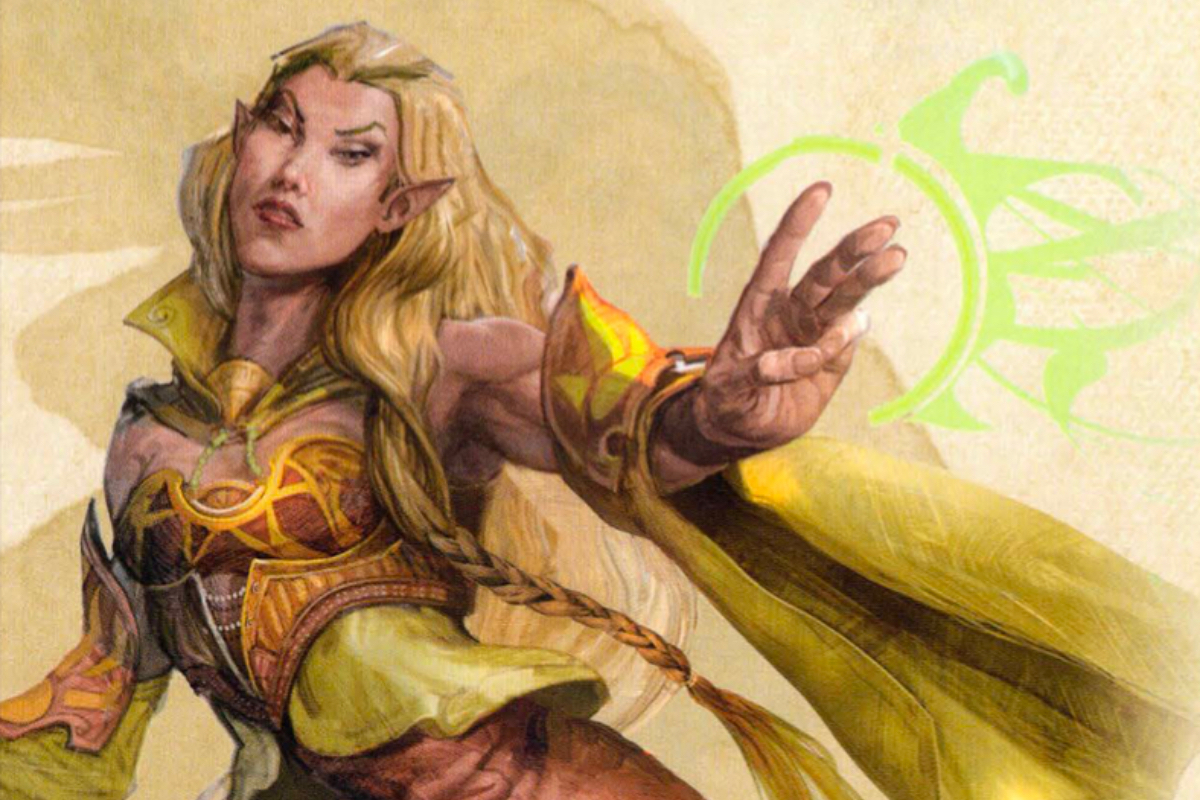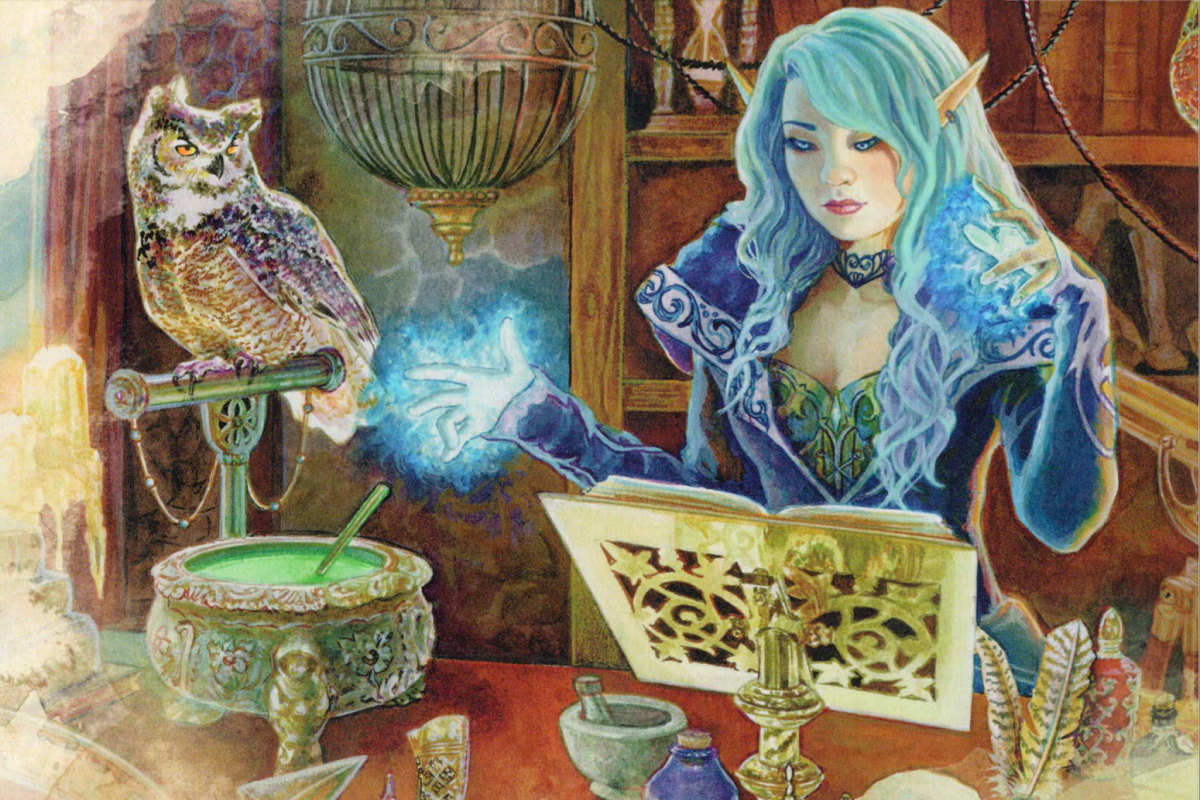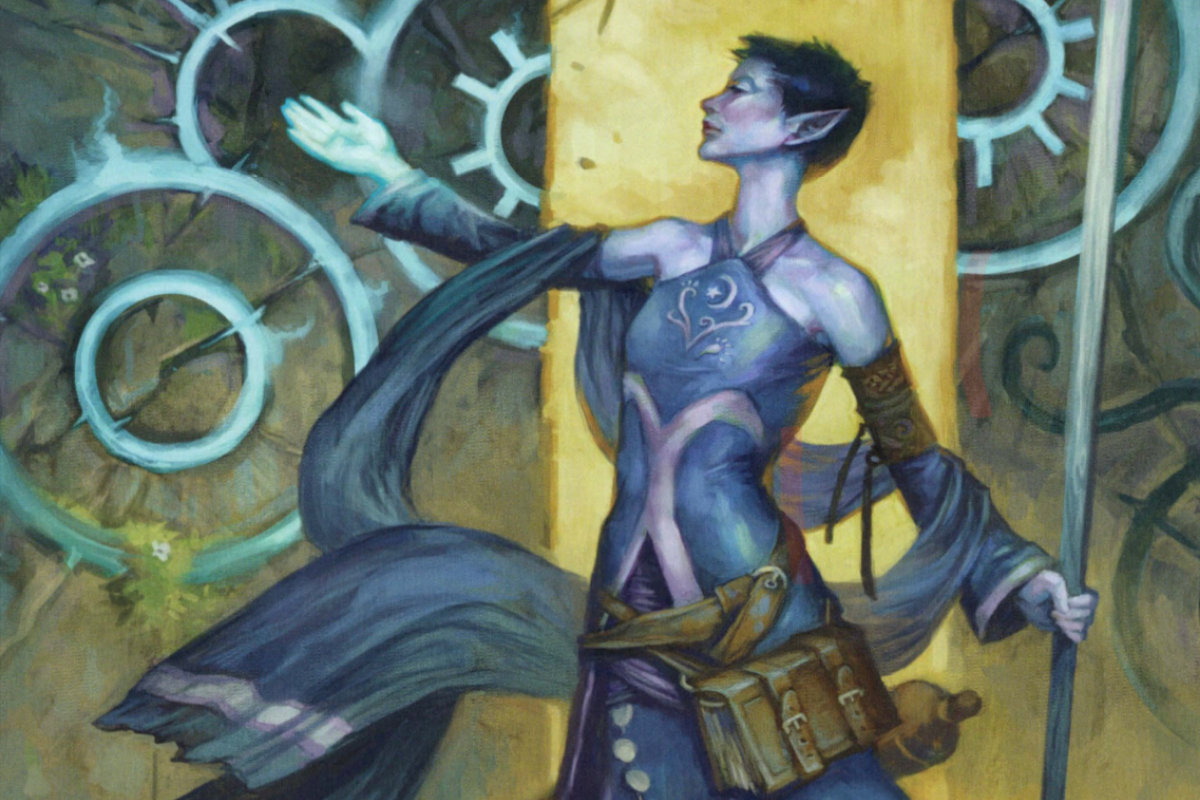Feature image and all other queer Dungeons and Dragons art from the 10th edition of the Player’s Handbook.
When you hear the words Dungeons and Dragons, who immediately comes to mind?
Hold on to that.
D&D, for those who have never played before, is a tabletop roleplaying game. To give the simplest description of how the game operates: Players assume the identity of a fictional character and make improvised choices based on their character’s background and disposition. The success or failure of their choices is dependent on the character’s individual abilities and an element of chance (in the case of D&D, the roll of a twenty sided die). The narrative of the game itself is facilitated by a Game Master or Dungeon Master, who describes (and/or creates) the world in which the players explore. They also act as every other character the players come in contact with, and present the players with challenges, obstacles, and rewards.
I, a trans woman, have been running games for the last eight years. Of the hundreds, if not thousands, of hours I’ve played D&D (among many, many other games) the most meaningful game I’ve ever played has been the one-on-one game I run for my boyfriend, Max. Our first session started in a Virgina hotel room, the day after he got top surgery.
While it might seem like an inopportune time to introduce him to tabletop role playing games, my reasoning was based on a non-insignificant amount of scientific research about the therapeutic potential of TTRPGs. I wanted him to spend the days after this momentous, transformative moment feeling like a hero. I wanted him to live in a world where his gender was nothing less than euphoric in every moment. Between our shared imagination and a series of dice rolls, this silly, beautiful, magic game enabled that.
If you play TTRPGs, you know a trans woman named Rowan who plays D&D is, at this point, simply a cliche. But if your primary exposure to D&D is through Stranger Things, or those two episodes of Community, you probably wouldn’t imagine anything I just said to be possible. You may have been made to feel (directly or indirectly) like D&D “wasn’t for you.” You’ve probably imagined all D&D players as cishet white men, who live out violent colonial fantasies in a world of make believe. And if you were basing those ideas on D&D’s 1974 origins, you wouldn’t be wrong.

D&D: A Problematic History
As Antero Garcia explains in his article Privilege, Power, and Dungeons & Dragons, D&D developed out of the wargaming communities of the mid 20th century. That gaming culture was composed largely of cishet white men creating games for other cishet white men. As Garcia states, the social rules of the game world plays “a significant role in shaping the experience and limitations on players’ experiences.” The experience player’s have at my table is not the same as D&D co-creator Gary Guygax’s players, because the ideologies that inform the game’s worldviews are fundamentally different. To put it lightly, old school D&D was severely limited in its cultural imagination.
Cis women weren’t even mentioned or included as playable characters until four years after the game’s initial debut — despite the lead designer’s daughter being a playtester. The original rulebook exclusively refers to players and NPCs as men. The following edition of the game, Advanced Dungeons and Dragons, acknowledges this choice and says, “These names can easily be changed to the feminine if desired. This is fantasy—what’s in a name? In all but a few cases sex makes no difference to ability!” How progressive.
Of course, if you chose to play as a woman, your maximum strength was lower than that of a man. Even in these men’s fantasy worlds, women couldn’t possibly be stronger than men. To describe the multitude of ways the historical foundation of D&D is steeped in colonial hierarchy would take a whole other article and a thousand hours of twitter discourse.
Though pockets of that culture certainly still exist, the vast majority of people engaged in the hobby today firmly reject that worldview. D&D has had a cultural reckoning, with the most recent edition (fifth edition or 5e) attempting massive overhauls to make the game more inclusive to queer people and people of color.
The introduction of 5th edition, with more streamlined rules and inclusive language, made D&D more accessible and popular than ever. That increase in popularity was aided by actual plays like the all-trans, POC-led Transplanar, or Dropout’s Dimension20, where queer and trans players have been present in every season of the show.
For those uninitiated, “actual play” is a narrative medium in which one or more people create an improvised show by playing a tabletop role-playing game like D&D. According to a preliminary study conducted by AP and TTRPG Historian Dr. Emily Friedman, of the over 4300 respondents who consumed ttrpg-related content, “female-identified and non-binary [audiences] are the majority in every age group, and that increases with each younger generation.”
So how do we find ourselves here? How did we go from this history to Dimension20’s Dungeons and Drag Queens, where four iconic queens from RuPaul’s Drag Race tell a beautiful story by playing D&D. (Yes, really. Jujubee, Monet X Change, Alaska, and Bob The Drag Queen. Honestly, go watch it right now. Finish the article later. I’ll wait.)
It’s simple: In worlds that reject our humanity, queer people have always imagined new ones.

Queer D&D As Transgressive Social Play
At its core, D&D is a vehicle for storytelling, a vessel for play. Through play, we can take risks in the safety of a fictional container. According to Garcia, “the opportunities for transgressive social play” are only limited by what possibilities are presented by the game itself. And if anyone’s good at transgressive social play, it’s queer people.
When you’re playing a TTRPG, you aren’t just creating a new self. You’re creating a new world, where anything is possible. “In so many ways, the only limit you have when playing TTRPGs is your imagination,” said Connie Chang, creator of Transplanar and designer of the game Godkiller. “Sure, there are rules and lore depending on the system you’re playing, but there’s no cop looming over your shoulder, telling you what you can or can’t do at your table.”
For those of us intimately familiar with the arbitrary limitations of binary gender expression, this isn’t too strange a concept. Gender itself is a game that every queer person learns to play very early on.
In the real world, imagining new ways of being and relating are essential to developing a sense of one’s queer or trans identity. In D&D, your character’s gender is entirely yours to invent. When you’re already embodying the experience of a half-elf or a cat person, playing a person of another gender — perhaps one that aligns more with your own — isn’t all that strange. From there, anything is possible.
“When I first started tabletops I was a cis pansexual man,” said Dare Hickman, a performer on Transplanar. “As I played with femininity with my characters (namely elves, the way they performed androgyny really spoke to me), I found myself more comfortable with queer expression.”
That level of exploration doesn’t just happen as a player though. As a Dungeon Master, or the individual running the game, the ability to explore every facet of gender is exponentially higher. “Running NPCs was so valuable in my gender journey,” said J Strautman, game designer and co-DM of the actual play show Planet Arcana. “At the drop of a hat I would have to try on a new gender, new pronouns, a new name, even a new voice. It wasn’t long before I found myself doing the same out of games.”
“As a game master, I embody hundreds of different characters over the course of a campaign,” said Chang. “It’s a way for me to explore my own sense of self alongside my players in a curated, creatively brave space — not just my gender, but other aspects of my identity as well.”
That new-found understanding doesn’t stay contained to the world of the game. The lessons learned at the table stay with you forever. “When we play at gender (both in a game space and outside of it) the being we are changes,” said Jay Dragon, award-winning designer of games like Wanderhome and Yazeba’s Bed & Breakfast. “TTRPGs helped me realize that all of life is character creation. My gender is another game I get to play with people around me; my identity and my pronouns [are] strategic tools of self expression, some inarticulate way of gesturing towards a deeper truth that no one can see. A character is a mask, and my gender is another mask, and both of them are ways I can become something more.”

Only As Queer As Your Table
Unfortunately, our internal understanding of our identity is constantly confronted and in conflict with the biases and expectations others assign to our physical bodies. If gone unexamined and unchecked, the systems of oppression that underpin our world will permeate systems within the game. To quote Garcia, what is possible to explore in a TTRPG is limited by the “constraints of what a gaming system will allow.”
The mechanical rules of old school D&D create an experience catered towards the biases of its creators. More modern versions of the game, played by a vastly queer demographic, offer many more possibilities, but are still limited to how far from D&D’s euro-centric fantasyland roots your table is willing to venture. Like any piece of art, the politics and social norms of your game are dependent on the worldviews of the people telling the story.
It wasn’t simply playing as an elf that facilitated Hickman’s internal exploration, it was the composition of the people at her table and the world they collectively created. “After I began playing at a mostly trans table,” said Hickman, “I was able to explore that sense of comfortability even more.”
That level of exploration simply wouldn’t be possible at a table occupied by players with a “traditional” understanding of D&D. Among those transformative tables Hickman has played at, maybe none have been so visibly trans as Transplanar. An explicitly anti-orientalist, non-colonial actual play, Transplanar is helmed by performer, writer, and game designer Connie Chang — whose identities inevitably shape the type of stories they tell, allowing for a more expansive reality of what TTRPGs have to offer.
“Being queer and trans […] informs the way I see the world from a foundational level.” said Chang. “When I worldbuild as a game master, I don’t define societies around gender roles or assign innate abilities or behaviors around gender.” That doesn’t mean the worlds of Transplanar are genderless. In fact it’s quite the opposite — Gender is brimming from every corner of their fabricated universes. “The concept of gender does exist, but it’s not used as a tool to oppress women and queer people. It’s playful. It’s fun. It’s euphoric and idealistic and so much more creatively enriching than playing at tables where real-world transphobic, queerphobic, and misogynistic philosophies around gender are uncritically upheld.”
Of course, not everyone is as enthusiastic about Transplanar’s radical imaginings. “Some (straight, cis, male, white, pick your combo) people sneeringly ask, ‘That sounds BORING, so everyone gets along? WHERE’S THE DRAMA?’ which I honestly think is hilarious,” said Chang. These comments aren’t a reflection of the show’s content, but of the limitations of their critic’s biases. “If you can’t imagine ways to create conflict outside of sexist, racist, transphobic, and/or homophobic violence, then your imagination is quite small.”

The Limits of D&D
Though D&D has the most name recognition, it’s only one of many games in the endless medium that is TTRPGs. “TTRPGs, in their most compelling form, are mechanisms for delving into elaborate social systems and dismantling them from the inside,” said Dragon.
Most contemporary approaches to gaming lean into the medium’s flexibility and dependance on the enthusiastic investment of the people playing. “Many game books even straight-up tell you that you should use the rules that you’re excited about and discard the ones that won’t work,” noted Chang. “This is the core and greatest advantage that TTRPGs have over other ludic vehicles such as video games: the medium itself cannot restrict you. A TTRPG is just a bunch of words on a page; if you don’t do exactly what they say, what’re they gonna do, papercut you to death?”
Games like Chang’s, Dragon’s, and Strautman’s enable exploration beyond binary imaginings of gender. “As part of the character creation process,” said Chang about their game Godkiller, “the player selects or creates a gender for their character, the titular Godkiller. The options include stuff like god’s tongue, wretched, haunted, and queer. Of course, you can always make up your own so you can name your gender however you want — e.g., woman, nonbinary, trans man, etc. But the default settings are a bit weird and monstrous by design, to decenter cis ways of imagining the world.”
Dragon’s games use gender as a central method of play and exploration. “Sleepaway, my first game, uses gender as a canvas to discuss queer existence outside belonging, playing with gender in a space where gender has permission to function as a game. My later projects, such as Yazeba’s Bed & Breakfast, imagines gender as a kaleidoscope of expression, an allegorical tool, and a literal method of community building.”
Strautman, who’s games like Insatiable Cravings and Contact focus on themes of shifting and body modification, said TTRPGs enabled them to understand what gender means for them beyond physical presentation and pronouns, “I find that process very spiritual and difficult to grasp, but easy to access when I’m able to comfortably be a different person for a set period of time. It’s the same feeling I have when I try to explain to someone that I just ‘know’ what my gender is. I just know.”
Though many people have used TTRPGs to explore their gender, the act of ineffable self discovery is just breaking the surface of what games can do for people — queer or otherwise. “TTRPGs are not special because they can crack some people’s eggs,” said Dragon. “I don’t make games about egg-cracking — I instead am seeking a way to radicalize gender, and shift away from the liberal framework of gender as identity to a framework of gender as action, gender as weapon, gender as a mask. I think games are a framework to accomplish this.”

TTRPGs as Tools For Liberation
As much as TTRPGs can facilitate exploration of more intrinsic aspects of one’s humanity — morality, confidence, empathy — they can replicate dehumanizing elements as well. “Games are just as much in danger of maintaining oppressive systems as they are able to challenge them,” said Dragon. Dragon’s interest in games focuses primarily on “their function as a way to liberate ourselves and step deeper into the game-state of surviving at the end of the world.”
This liberation is similar to what Chang is attempting to enable for themself, their players, and his audience through Transplanar and her work in the TTRPG ecosystem at large. “I collaborate to imagine worlds that don’t currently exist, but that we hope one day will. Because I intentionally play with other trans and queer people and people of color, these worlds undertake liberational and revolutionary approaches to gender, race, ethnicity, disability, sexuality, and so many other axes of marginalization,” Chang said.
“The real world hates, fetishizes, oppresses, and exploits us enough already. But in our imaginary worlds, we create possibilities and, most importantly, joys surrounding our experiences as marginalized people. I’ve said it before and I’ll say it again: trans joy is revolutionary. Transphobes want us invisible, maimed, dead. Sometimes, there is no greater act of resistance than simply being alive, euphorically and unapologetically. Playing TTRPGs with other trans people who get this is an indescribably affirming experience. It’s a way to be in genuine queer community, where we’re all playing gay disasters trying our best to save a world that actually loves us.”

Dungeons and Dragons Player’s Handbook illustrators: Steve Argyle, Tom Babbey, Daren Bader, Drew Baker, Mark Behm, Eric Belisle, Christopher Bradley, Noah Bradley, Sam Burley, Clint Cearley, Milivoj Ćeran, Sidharth Chaturvedi, Jedd Chevrier, jD, Allen Douglas, Jesper Ejsing, Craig Elliott, Wayne England, Scott M. Fischer, Randy Gallegos, Justin Gerard, Florian De Gesincourt, Lars Grant-West, Jon Hodgson, Ralph Horsley, Lake Hurwitz, Tyler Jacobson, Kekai Kotaki, Olly Lawson, Raphael Lubke, Titus Lunter, Slawomir Maniak, Brynn Metheney, Aaron Miller, Christopher Moeller, Mark Molnar, Scott Murphy, William O’Connor, Hector Ortiz, David Palumbo, Alessandra Pisano, Claudio Pozas, Rob Rey, Wayne Reynolds, Aaron J. Riley, Chris Seaman, Cynthia Sheppard, Craig J Spearing, John Stanko, Matt Stawicki, Alex Stone, Thom Tenery, Cory Trego-Erdner, Beth Trott, Autumn Rain Turkel, Jose Vega, Tyler Walpole, Julian Kok Joon Wen, Richard Whitters, Eva Widermann, Ben Wootten, Kieran Yanner



“Through play, we can take risks in the safety of a fictional container.”
This is so helpful – thank you for this.
I want to add that some queer people do enjoy stories where discrimination exists or is a plot point, and there’s nothing better or worse about it. What’s exciting about people creating settings without discrimination is that discrimination is seen as an obligatory part of a TTRPG setting, and it’s a big step as a community to admit that there isn’t just one way to do it, that some players don’t want to engage with tropes that are treated as an inherent part of the setting, and that tabletop roleplay is flexible enough to accommodate those players, too. But whatever you’re into is fine – some people fantasize about a world without bigotry, and some people fantasize about being able to react to bigotry in cathartic ways. You also have people who don’t want to roleplay real-life sexism and racism, but enjoy stories where elves and dwarves don’t like each other or basically everyone has a problem with tieflings. If you find a group that fits your priorities and respect the other people at the table, then you’re not doing it wrong.
This ^^
I mostly play my D&D characters as unspecified on the trans/cis aspect if it’s in discrimination-free worlds, but the few times I’ve wanted to play as a specifically trans character it’s been because I want to go through catharsis. It’s not for everyone, but as somebody who transitioned a long time ago and has realised I’m always going to live in a transphobic world, a trans character who has a good life despite also living in one is far more hopeful and positive to me than a trans character who has simply never experienced transphobia.
This reminds me of an incident from over 20 years ago. I played a lot more TTRPGs back then (wish I could find more games these days, but I’ve spent too much time moving around). Anyway, I was still in the closet back then, but every character I played in TTRPGs (with the exception of the last time I played D&D, but my characters were dying so much in that campaign that I began randomizing literally everything about them) was female. Well, one time at the start of a new game a good friend of mine back then must have noticed because he asked me why I always played female characters. At the time, I answered something along of the line that nobody else was so I felt somebody should. Now I can clearly see that I was exploring my gender identity through roleplay.
This post beautifully captures the essence of how TTRPGs, particularly D&D, can serve as a powerful platform for exploring and expressing diverse gender identities. I love how it emphasizes the importance of inclusivity and representation in gaming communities. It’s refreshing to see discussions around creating more welcoming spaces for queer players. Thank you for shedding light on this vital topic!
This post beautifully highlights the importance of representation in TTRPGs! I love how it explores the fluidity of gender and identity within the gaming space. It’s so empowering to see stories that reflect our diverse experiences. Can’t wait to incorporate these ideas into my own campaigns!